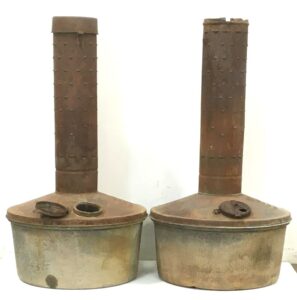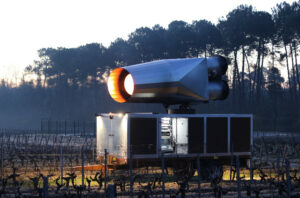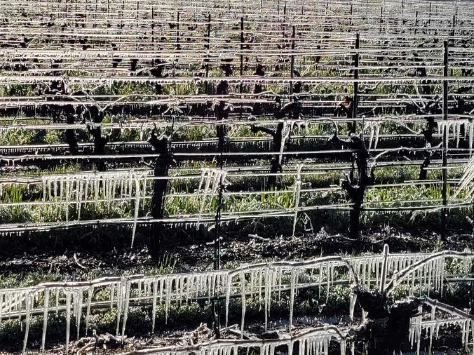Protection from Frost
“The Good Stuff”
March 29, 2023
Virginie Boone
Protection from Frost
As we ramble into spring, after a much cooler, wetter winter than we’ve had in Sonoma County in a long while, the grape grower’s mind turns to the tiny little shoots that will one day turn into grapes and how best to protect these delicate babies from five of the worst letters in agriculture: F-R-O-S-T.
Heaters, wind machines and sprinklers are all within the arsenal of tools that are used to protect these burgeoning shoots so that down the line they live long enough to flower, be fertilized and develop into berries.
Heaters are used to heat the outside temperature found near the height of the vines above freezing. The National Weather Service considers a temperature of 32 degrees F a light freeze. A moderate freeze is between 29 degrees F and 32 degrees F. A hard or severe freeze is when temperatures fall to 24 degrees F or below.
For vines the amount of frost to worry about can depend on the variety of the grape, how early ripening occurs in the calendar year, for example, and on other factors like wind. The threat of frost keeps grape growers up at night throughout any cold snap.
One of the early ways of heating up a vineyard was with a smudge pot, which is still used in many forms of agriculture and in other wine regions of the world but has long been out of use in Sonoma County.
In fire-weary California the sight of an open flame burning near grapevines can make your heart skip a beat. Additionally, smudge pots run on diesel, kerosene, cooking oil or used motor oil, all scents you likely do not want near your future grapes.
Smudge pots are about 4-feet-tall and have a round base with a chimney that emits smoke from the middle of the base. They were invented by W.C. Scheu of Colorado, who came up with this oil-burning stack heater in 1907 to heat fruit orchards, especially citrus trees. His company, Scheu Steel, still exists, and is based in Upland, California.
Typically, these pots would hold around 5 gallons of diesel that would smolder for around 6 hours or so, fewer the colder it was. Refilling them took a lot of work and money.
They became a common way to heat orchards and vineyards for decades before environmental concerns – the smoky air and resulting soot (or smudge) was no joke – and the price of the oil to fill them made them less sustainable over time. Many farmers facing freezing temperatures would have to light hundreds of smudge pots at a time to protect their orchards or vineyards.
They certainly set off one reader (name withheld), who wrote a letter to “The Press Democrat” in March of 1965 titled, “Orchard Smudge Pots Get This Reader Hot.”
“The frost in the air reminds me that it’s about time for orchardists… to awaken in the wee hours of the morning, jump out of bed, light their smudge pots and turn on their wind machines; a few will even light up their old tires! We’ll be thinking how we’ll have to wash our houses inside and out and repaint them, come the end of ‘smudging’ time.”
The eruption of 300 smudge pots filled with diesel oil on the Hiatt Ranch in Cloverdale in 1974 didn’t help. Smudge pot fires were not an unusual occurrence.
Nowadays, you may sometimes find them lying lifeless around vineyards, long out of use, or on farm equipment auctions and EBay, where they more often than not are riddled by rust.
With all things, farmers are motivated to find opportunities to be softer on the land while still protecting their crop. One of the things that helped to replace smelly, dirty smudge pots was the wind machine, which mixes the cold dense air sitting around the vines at ground level with the warmer temperatures that rise higher to the top of the inversion layer, raising the air temperature around the vines by enough degrees to make a difference.
Windmills date back to the 1920s and were pioneered first in California for citrus trees. Some have an engine mounted at the top of the fan; on others, the engine is on the ground; both two and four-blade fans are common and rotate at a speed of around 600 rpm, drawing air from the top and blowing it down toward the ground.
They work best when the air is relatively calm and clear. If there’s too much wind naturally, there won’t be enough warm air to mix. It’s additionally important to turn them on before temperatures reach below freezing. Both electric and internal-combustion wind machines exist.
When a fixed wind machine wasn’t available, sometimes helicopters served as a source of frost protection, hovering above a vineyard or orchard long enough to mix the air. Heli Team in Florida offers helicopter frost protection to circulate over crops, saying it can cover 50 acres per helicopter. Imagine the cost for that protection (estimated at $10,000/night).
While they don’t smell or pollute, wind machines aren’t always popular because they’re noisy (don’t even start with helicopters), but a very reasonable price to pay for living in an agricultural region that only needs them for a limited amount of the year.
Sprinklers on the other hand neither make much noise nor pollute the air but need of course water to run.
The water used in overhead vineyard sprinklers protects young vine leaves and shoots by coating them in ice, maintaining their temperature at 32 degrees F and thus encasing them from exposure to even colder air. The water also simultaneously warms the soil, helping to warm the plants from the roots up.
Sprinkler systems and reservoirs to feed them started replacing smudge pots in Sonoma County in the mid to late 1970s.
Technological solutions continue. At Washington State University they have created a “spray on” frost protection using cellulose nanocrystals, a common polymer, finding a single application could protect baby buds until warmer weather triggered new growth.
Newer still on the horizon, in 2022 a mobile hot-air cannon was wheeled out into a vineyard in Bordeaux, France, to protect vines. Designed in response to the region’s devastating frosts of April 2021, the cannon has a power of 1.8 million watts and can be hitched to a tractor and operated while driving. It circulates air while generating heat, running on biofuel. The price tag? €130,000 (about $140,000).




